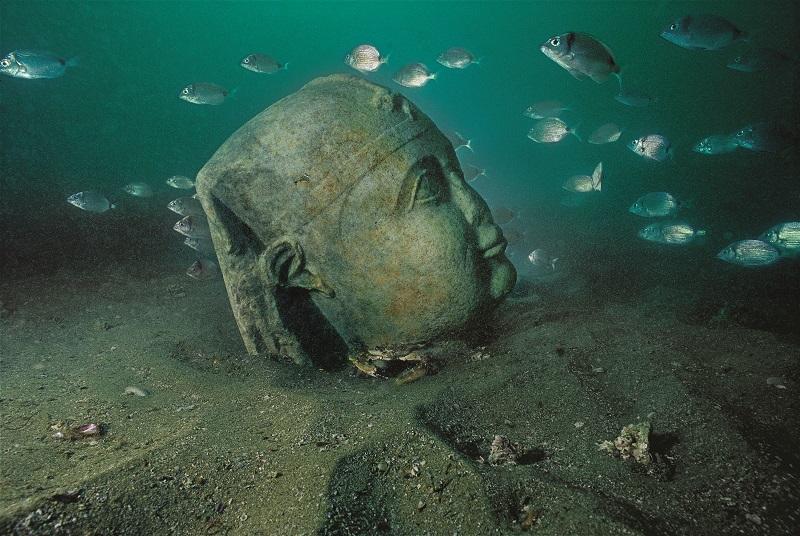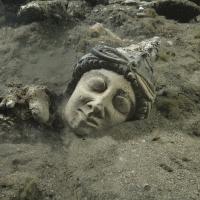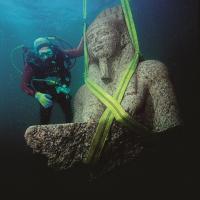Sunken Cities: Egypt's lost worlds rediscovered | reviews, news & interviews
Sunken Cities: Egypt's lost worlds rediscovered
Sunken Cities: Egypt's lost worlds rediscovered
Forgotten for over 1,000 years, eerily evocative treasures take centre stage at the British Museum

In a gallery darkened to evoke the seabed that was its resting place for over a thousand years, the colossal figure of Hapy, the Egyptian god of the Nile flood, greets visitors just as it met sailors entering the busy trading port of Thonis-Heracleion some 2,000 years ago.
They were known about through ancient texts, but it wasn’t until the 1930s that the first remains were discovered, with their exact locations pinpointed at the edge of the Nile delta only 20 years ago. Excavations have been ongoing ever since – an array of objects, beautifully preserved by the sea, offering a vivid picture of two cosmopolitan and culturally diverse cities, their fortunes intimately connected to the power of river and sea.
The fruits of the relationship between Greece and Egypt are seen in the form of sculptures that combine distinct idioms, while devotional objects show the assimilation of Greek and Egyptian gods. After centuries of trade between the two countries, Alexander the Great’s conquest of Egypt in 332 BC saw the beginning of a period of even closer cultural exchange, with Ptolomeic rulers depicting themselves as pharaohs in an attempt to gain acceptance (main picture). An eerily beautiful sculpture of a Ptolomeic queen shows her as the Egyptian god Isis. The walking posture and the use of dark Egyptian stone instead of marble are characteristically Egyptian, as is the treatment of the face. The draperies, and the hair, however, are typically Greek.
Despite the many artefacts that have been recovered, it is thought that only a tiny percentage of the underwater site has been excavated so far. But the picture that emerges is of a complex and nuanced relationship between two great civilisations, in which sculpture played a central role.
- Sunken Cities: Egypt's Lost World's at the British Museum until 27 November
Click on the thumbnails to enlarge
Explore topics
Share this article
The future of Arts Journalism
You can stop theartsdesk.com closing!
We urgently need financing to survive. Our fundraising drive has thus far raised £33,000 but we need to reach £100,000 or we will be forced to close. Please contribute here: https://gofund.me/c3f6033d
And if you can forward this information to anyone who might assist, we’d be grateful.

Subscribe to theartsdesk.com
Thank you for continuing to read our work on theartsdesk.com. For unlimited access to every article in its entirety, including our archive of more than 15,000 pieces, we're asking for £5 per month or £40 per year. We feel it's a very good deal, and hope you do too.
To take a subscription now simply click here.
And if you're looking for that extra gift for a friend or family member, why not treat them to a theartsdesk.com gift subscription?
more Visual arts
 Help to give theartsdesk a future!
Support our GoFundMe appeal
Help to give theartsdesk a future!
Support our GoFundMe appeal
 Best of 2024: Visual Arts
A great year for women artists
Best of 2024: Visual Arts
A great year for women artists
 Electric Dreams: Art and Technology Before the Internet, Tate Modern review - an exhaustive and exhausting show
Flashing lights, beeps and buzzes are diverting, but quickly pall
Electric Dreams: Art and Technology Before the Internet, Tate Modern review - an exhaustive and exhausting show
Flashing lights, beeps and buzzes are diverting, but quickly pall
 ARK: United States V by Laurie Anderson, Aviva Studios, Manchester review - a vessel for the thoughts and imaginings of a lifetime
Despite anticipating disaster, this mesmerising voyage is full of hope
ARK: United States V by Laurie Anderson, Aviva Studios, Manchester review - a vessel for the thoughts and imaginings of a lifetime
Despite anticipating disaster, this mesmerising voyage is full of hope
 Lygia Clark: The I and the You, Sonia Boyce: An Awkward Relation, Whitechapel Gallery review - breaking boundaries
Two artists, 50 years apart, invite audience participation
Lygia Clark: The I and the You, Sonia Boyce: An Awkward Relation, Whitechapel Gallery review - breaking boundaries
Two artists, 50 years apart, invite audience participation
 Mike Kelley: Ghost and Spirit, Tate Modern review - adolescent angst indefinitely extended
The artist who refused to grow up
Mike Kelley: Ghost and Spirit, Tate Modern review - adolescent angst indefinitely extended
The artist who refused to grow up
 Monet and London, Courtauld Gallery review - utterly sublime smog
Never has pollution looked so compellingly beautiful
Monet and London, Courtauld Gallery review - utterly sublime smog
Never has pollution looked so compellingly beautiful
 Michael Craig-Martin, Royal Academy review - from clever conceptual art to digital decor
A career in art that starts high and ends low
Michael Craig-Martin, Royal Academy review - from clever conceptual art to digital decor
A career in art that starts high and ends low
 Van Gogh: Poets & Lovers, National Gallery review - passions translated into paint
Turmoil made manifest
Van Gogh: Poets & Lovers, National Gallery review - passions translated into paint
Turmoil made manifest
 Peter Kennard: Archive of Dissent, Whitechapel Gallery review - photomontages sizzling with rage
Fifty years of political protest by a master craftsman
Peter Kennard: Archive of Dissent, Whitechapel Gallery review - photomontages sizzling with rage
Fifty years of political protest by a master craftsman
 Dominique White: Deadweight, Whitechapel Gallery review - sculptures that seem freighted with history
Dunked in the sea to give them a patina of age, sculptures that feel timeless
Dominique White: Deadweight, Whitechapel Gallery review - sculptures that seem freighted with history
Dunked in the sea to give them a patina of age, sculptures that feel timeless











Add comment